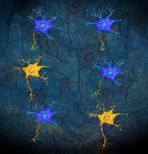In order to fully understand the challenges faced by someone who has suffered a brain injury, you must first understand the complexity of the human brain.
The human brain only weighs a few pounds but it is made up of billions of cells that must be able to communicate with one another quickly and efficiently in order for the brain, and the rest of your body, to work properly.
The Brain’s Building Blocks:

The brain is made up of billions of cells called neurons. I have found that the easiest way to understand how a neuron works is to think of a neuron like a light switch in your house. The switch can either be turned on (in which case the neuron is transmitting electrical energy) or it can be turned off (and the neuron does not transmit electrical energy).
Each neuron has an axon that sticks out of the neuron’s cell, sort of like an electrical wire. Electrical impulses travel from the neuron down the axon. When the electric impulse reaches the end of the axon it creates a chemical reaction that jumps across a gap (called a synapse) where it triggers another neuron to send another message.
A Telephone SystemThe brain’s communication system is something like the telephone system. Imagine the telephone system in New York City, a city of more than 8 million people. New York has an incredibly complex system of wires and computers that communicate information throughout the telephone system.
 When parts of the brain are injured the neurons are not able to communicate with one another.
When parts of the brain are injured the neurons are not able to communicate with one another.If you damage a small part of the communication system (for example if you cut the wires running into an apartment building) the result may only affect a few hundred people, a very small part of the city.
But if you damage a major trunk line containing thousands of telephone wires it may cut off communication to several blocks or even the entire city.
When you consider the “telephone system” analogy you can see how an injury to even a small part of the brain could have very serious effects if the part of the body that the brain communicates with serves a critical function.
Do You Think You Need Our Help?
Halifax Brain Injury lawyer John McKiggan Q.C. has served on the board of the Brain Injury Association of Nova Scotia (Halifax Chapter) and is the author of Brain Matter: The Survivor’s Guide to Brain Injury Claims an educational resource for brain injury survivors and their families.
If you or someone in your family has suffered a traumatic brain injury, you can call brain injury lawyer John McKiggan Q.C. toll free at (877) 423-2050 or contact us online for a free consultation.











